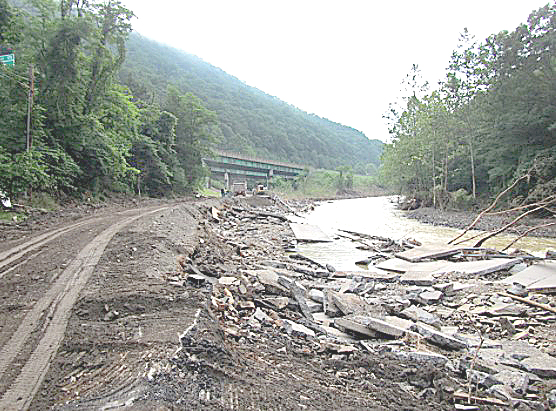
Five years after severe storms, floods, mudslides and landslides devastated large swaths of central and southern West Virginia on June 22-29, 2016, the state continues on its road to recovery and is working to develop resilience against future disasters.
Twenty-three lives were lost in an event that affected 18 counties. Hundreds of miles of state roads washed away, and thousands of households were left in need of assistance. The Federal Emergency Management Agency (FEMA) and its local, state and federal partners have been working to bring communities back to normal again.
“To be clear, no amount of work or money will erase the heartache and suffering that the 2016 flood brought to the people of West Virginia,” said Janice Barlow, Acting Regional Administrator, FEMA Region 3. “Our best hope is that by putting our efforts not only into long-term recovery but toward building resilience, we will honor their memories and the fighting spirit of the Mountain State. I’m humbled that FEMA is a part of that healing process.”
To date, the FEMA Individuals and Households program has approved more than $42.3 million in helping nearly 5,000 residents and households in the 12 counties where Individual Assistance was designated.
In addition, FEMA’s Volunteer Agency Liaisons (VALs) have worked closely with West Virginia Voluntary Organizations Active in Disaster (WV VOAD) to coordinate more than 40 member organizations to help survivors with unmet needs, including home repairs, clearing out flood debris and, through its Bridges to Home program, the construction of more robust water crossings over creeks and streams to private residences.
FEMA’s Hazard Mitigation Grant Program (HMGP) helps communities reduce or eliminate long-term risk to people and property from future disasters. Since 2016, 83 HMGP projects have been approved with more than $31.6 million in federal dollars. One such project in Brooke County is increasing the capacity of one town’s storm/sewer water system to redirect storm runoff more efficiently and reduce the risk of flooding. In Raleigh County, an Acquisition/Demolition project allowed six families to relocate from their flood-prone properties to safer areas.
Other federal agencies, such as the U.S. Department of Housing and Urban Development (HUD), through its Community Development Block Grants, have approved more than $106.4 million for its Mitigation program and more than $149.8 million for Disaster Recovery projects, such as WV VOAD’s Bridges to Home program. Additionally, the U.S. Small Business Administration approved more than 800 low-interest loans worth more than $53 million to assist homeowners and businesses affected by the flood.
But the bulk of federal funding to the Mountain State has come in the form of Public Assistance (PA), with programs for state roads, the reconstruction of five schools and the demolition of structures irreparably damaged by flooding. As of June 11, FEMA’s PA program has approved 989 projects and more than $415.2 million in federal funds.
Given the number of projects and dollars involved in the recovery from the 2016 disaster, combined with the frequency of the state’s disaster declarations, FEMA Region 3 and the state’s emergency management division entered into an agreement in 2019 that established a West Virginia FEMA Integration Team (WV FIT) in Charleston. Under the agreement, the WV FIT increases FEMA’s ability to provide on-site technical assistance and rapid delivery of FEMA’s programs within the State of West Virginia and enhances FEMA’s direct coordination with state partners.
The urgency to recover from 2016 galvanized the state as well. A year after the flood, the state established a Joint Legislative Committee on Flooding and, through it, a State Resiliency Office (SRO) to provide coordination among government agencies for emergency and disaster planning, response, and recovery. Then, in 2020, the West Virginia Offices of the Insurance Commissioner appointed a new director of West Virginia National Flood Insurance Program (NFIP) to promote enrollment in the program and ensure proper land use and development to prevent flooding.
With leadership in place to directly address both resiliency and the chronic occurrence of floods, the state is positioning itself to be better prepared for what happens before and after disaster hits.
“Those lost or injured in this event hold a special place in our hearts and prayers,” said G.E. McCabe, director of the West Virginia Emergency Management Division. “We continue to work with our local, state and federal partners to offer as much recovery as possible to the survivors. Valuable relationships have been developed on behalf of the citizens of West Virginia. We will strive for continuous improvement as we move forward.”
While the 2016 flooding left much suffering and damage in its wake, the move to come back stronger is leading to a recovery effort that is truly locally led, state-managed and federally supported.
Additional information on West Virginia’s recovery from the 2016 flood can be found at www.fema.gov/disaster/4273. Learn more about the West Virginia Emergency Management Division at emd.wv.gov and West Virginia Voluntary Organizations Active in Disaster at www.wvvoad.org. For more information on the National Flood Insurance Program go to https://www.floodsmart.gov.



